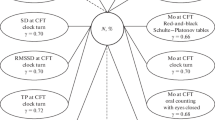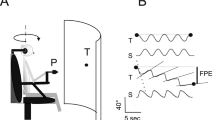Summary
A modification of mental arithmetic (MMA) combined with a key press technique was used to raise the patients' level of vigilance during routine investigation of vestibular function. The effect of MMA is studied by comparing succeeding pendular tests under different conditions. Group I: 81 patients had the first pendular test without and the second with MMA. Control group II: 31 patients had the tests in opposite order. The nystagmograms were analysed by computer.
The application of the MMA-method resulted in a significantly increased average reaction intensity with differences up to 20% and more, according to the considered nystagmus parameter. This effect does not depend on the chronological order of the tests with or without MMA. On the other hand, in both groups a higher level of vigilance is correlated with less nystagmic beats (5–8%). Therefore, the number of beats does not show the characteristics of typical intensity parameters. The comparison of the absolute values of the analysed parameters shows good reproducibility of the average results under identical circumstances. In the last 4 years the MMA-method turned out to be easily applicable.
For all these reasons, this method was included into the routine examination of vestibular system function to raise and keep constant the level of vigilance.
Zusammenfassung
Zur Steigerung und Erhaltung des Wachheitsgrades während routinemäßiger Gleichgewichtsprüfungen wurden an Stelle des bekannten Kopfrechnens einfache Rechenaufgaben vom Tonband vorgespielt, auf die der Patient per Knopfdruck antworten mußte. Die Wirksamkeit dieses Verfahrens wurde für zwei Patientengruppen durch Vergleich aufeinanderfolgender Pendelprüfungen untersucht. Bei 81 Patienten der einen Gruppe wurde die erste Pendelprüfung ohne, die zweite mit Rechenaufgaben durchgeführt, bei der Kontrollgruppe mit 31 Patienten war die Reihenfolge umgekehrt. Die Nystagmogramme wurden am Rechner ausgewertet.
Die Anwendung der Rechenaufgaben brachte je nach Parameter einen signifikanten Anstieg der durchschnittlichen Reaktionsstärke um bis 20% und darüber. Dieser Effekt zeigt sich unabhängig von der zeitlichen Reihenfolge der Pendelprüfungen mit bzw. ohne Rechenaufgaben. Anders verhält sich die Schlagzahl. In beiden Gruppen nimmt diese bei erhöhter Vigilanz ab (5–8%). Diese Kenngröße weist also nicht die Eigenschaften der typischen Intensitätsparameter auf. Aus dem Vergleich der absoluten Größen der Durchschnittswerte folgt eine gute Reproduzierbarkeit unter gleichzuhaltenden Bedingungen. In über 4 Jahren hat sich die leichte Anwendbarkeit des beschriebenen Verfahrens erwiesen.
Diese Ergebnisse waren Anlaß, die Tonband-Rechenaufgaben zur Vigilanzsteigerung und -erhaltung als festen Bestandteil in die routinemäßige Gleichgewichtsuntersuchung einzuführen.
Similar content being viewed by others
Literatur
Albert HH von (1968) Vestibuläre Habituation. Die Reaktion des menschlichen Vestibular-apparates auf wiederholte rotatorische Reizungen. Fortschr Med 86:505–508
Aschan G (1968) Habituation to repeated rotatory stimuli (cupulometry) and the effect of antinausea drugs and alcohol on the results. Acta Otolaryngol (Stockh) 64:95–106
Brown JH (1966) Interacting vestibular stimuli and nystagmic habituation. Acta Otolaryngol (Stockh) 62:341–350
Brown JH, Crampton GH (1964) Quantification of the human nystagmic response to angular acceleration. Prediction formulae and nomograph. Acta Otolaryngol (Stockh) 58:555–564
Collins WE (1962) Effects of mental set upon vestibular nystagmus. J Exp Psychol 63:191–197
Collins WE, Guedry FE (1962) Arousal effects and nystagmus during prolonged constant acceleration. Acta Otolaryngol (Stockh) 54:349–362
Gillingham KK (1969) Mental arithmetic during electronystagmographic testing. Ann Otol Rhinol Laryngol 78:575–586
Guedry FE, Lauver LS (1961) Vestibular reactions during prolonged constant angular acceleration. J Appl Physiol 16:215–220
Hahn R (1970) Caractères nystagmographiques de l'habituation vestibulaire à des stimulations différentes. Acta Otorhinolaryngol Belg 24:405–408
Hofferberth B, Moser M (1981) Die Aufrechterhaltung eines gleichmäßigen Vigilanzniveaus bei der Elektronystagmographie. Laryngol Rhinol Otol (Stuttg) 60:255–258
Kornhuber HH (1966) Physiologie und Klinik des zentral-vestibulären Systems (Blick- und Stützmotorik). In: Berendes J, Link R, Zöllner F (Hrsg) Handbuch der HNO-Heilkunde, Bd. III/3. Thieme, Stuttgart
Moser M (1978) Die kleine Nystagmusschrift und Hypoxie der vestibulären Zentren. Arch Otorhinolaryngol 220:15–31
Moser M (1980) Die zentrale Nystagmusschrift und Irritation der vestibulären Zentren. Arch Otorhinolaryngol 226:135–143
Moser M, Ranacher G (1978) Klinische Ergebnisse der quantitativen Nystagmusanalyse. Arbeitstagung ADANO, Bonn 1978
Oosterveld WJ (1965) The torsion swing. Pract Otorhinolaryngol (Basel) 27:309–310
Oosterveld WJ, Graybiel A, Cramer DB (1973) Susceptibility to reflex vestibular disturbances and motion sickness as a function of mental states of alertness and sleep. Adv Otorhinolaryngol 19:286–294
Ranacher G (1975) Verfahren zur Nystagmusauswertung auf der Grundlage eines mathematischen Modells des vestibulo-okulomotorischen Systems. Diss Techn Hochschule Graz
Ranacher G (1977) Nystagmusauswertung am Computer. Arch Otorhinolaryngol 215:257–263
Ranacher G (1979) Das Kumulogramm der Pendelprüfung. Arch Otorhinolaryngol 222:53–61
Ranacher G (1979) Nystagmometrie und Biokybernetik. Arch Otorhinolaryngol 224:267–283
Ranacher G (1979) Berechnung der vestibulären Kompensationsleistung aus einzelnen schnellen Nystagmuskomponenten (Pendelprüfung). Arch Otorhinolaryngol 225:283–290
Ranacher G, Moser M (1975) Datenverarbeitung in der Elektronystagmographie. Arch Otorhinolaryngol 211:93–104
Rubin W, Vandemoer N (1971) Nystagmus arousal during the latent period of caloric nystagmus. Laryngoscope 81:524–528
Sachs L (1978) Angewandte Statistik. 5. Aufl. Springer, Berlin Heidelberg New York
Torok N (1970) The effects of arousal upon vestibular nystagmus. Adv Otorhinolaryngol 17:76–89
Author information
Authors and Affiliations
Additional information
Mit Unterstützung des Österreichischen Fonds zur Förderung der wissenschaftlichen Forschung, Projekt Nr. 3087
Rights and permissions
About this article
Cite this article
Ranacher, G., Moser, M. Untersuchung zum Einfluß der Vigilanz auf die Nystagmusreaktion. Arch Otorhinolaryngol 234, 267–276 (1982). https://doi.org/10.1007/BF00464331
Received:
Accepted:
Issue Date:
DOI: https://doi.org/10.1007/BF00464331




